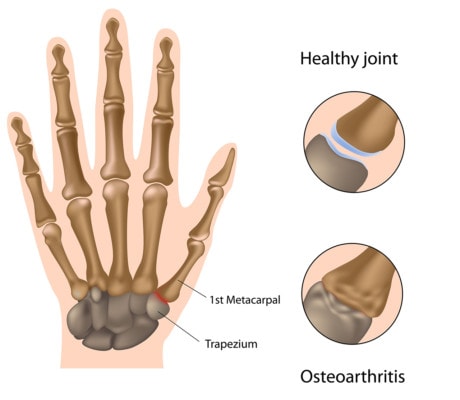An Artist’s Hand and Avoiding Thumb Surgery
Thumb arthritis is a major problem for all of us, but much worse for those of us who use our hands. This is the story of a revolutionary non-surgical procedure for those with CMC arthritis and an artist who got his grove back. Let’s dig in.
What Is the Thumb CMC Joint?

Alila Medical Media/Shutterstock
The thumb has a few joints and the one at the base of the thumb is called the CMC which stands for carpal metacarpal. This is located between the wrist bones (carpals) and the thumb bones (metacarpals). It’s one of the most common causes of hand arthritis and is more common in women than in men. In our technological world where we all use our hands for everything from phones to computers, this joint gets extra wear and tear.
The pain is felt at the base of the thumb. It’s usually worse when using the thumb, but it can be bad enough so that opening a door or shaking a hand can be tough. Wearing a splint or brace may help.
Surgical Options
The most common surgery for CMC arthritis is LRTI (Ligament Reconstruction and Tendon Interposition). This surgery involves removing a small wrist bone that’s the wrist part of the CMC joint and replacing it with a tendon from the hand. The procedure has significant side effects with about 1 in 7 patients reporting problems (1).
John’s CMC
It would be hard for someone like me who uses their hands to perform procedures all day to have severe CMC arthritis. However, it’s even worse for an artist. John is a multi-talented artist who gave up working with clay because of his thumb. He was told he needed surgery, but he wanted to avoid possible complications.
What did John do? He did this procedure:
We pioneered this Perc-CMC Arthoplasty procedure shown above that uses the patient’s own high-dose platelet-rich plasma to treat:
- The CMC joint arthritis
- The ligament laxity that causes the joint to move out of place
- The irritated median nerve in the wrist
How Did It Work?
This is John’s latest report:
“John Aaron here. Dr. Centeno’s patient for PRP last year. The artist whose left hand he restored. Please show him what my hand can do that it couldn’t for the past three years until I got treated by him. It still feels like a miracle. This is called Calm Before The Storm. I just posted it to You Tube. I wrote it, perform it on 12 string guitar and created the video with my art and photographs. So excited to be playing again, I just can’t tell you. Tell the doc thanks.
https://youtu.be/CZj4ZtTrdps
The Major Differences Between the Two Procedures

As you can see, the invasiveness of LRTI surgery is a big deal. The surgeon is removing a bone in the wrist and then severing a tendon in the hand and stuffing it into the area. The Perc-CMC procedure is a series of highly precise injections into the above structures using ultrasound guidance. The recovery for the more invasive surgical procedure takes several months. However, the injection-based procedure leaves the patients sore for a few days and recovery is “listen to your body”.
The upshot? John’s doing well at about 3 years out from his first procedure. He avoided a big surgery, got to keep creating his art, and now he’s back to playing guitar!
_________________________________
References:
(1) Naram A, Lyons K, Rothkopf DM, et al. Increased Complications in Trapeziectomy With Ligament Reconstruction and Tendon Interposition Compared With Trapeziectomy Alone. Hand (N Y). 2016;11(1):78-82. doi:10.1177/1558944715617215

If you have questions or comments about this blog post, please email us at [email protected]
NOTE: This blog post provides general information to help the reader better understand regenerative medicine, musculoskeletal health, and related subjects. All content provided in this blog, website, or any linked materials, including text, graphics, images, patient profiles, outcomes, and information, are not intended and should not be considered or used as a substitute for medical advice, diagnosis, or treatment. Please always consult with a professional and certified healthcare provider to discuss if a treatment is right for you.
